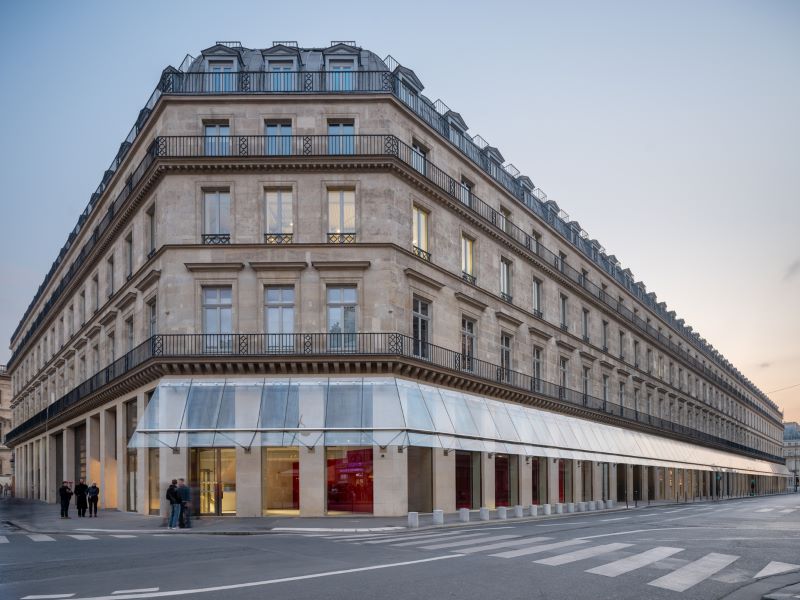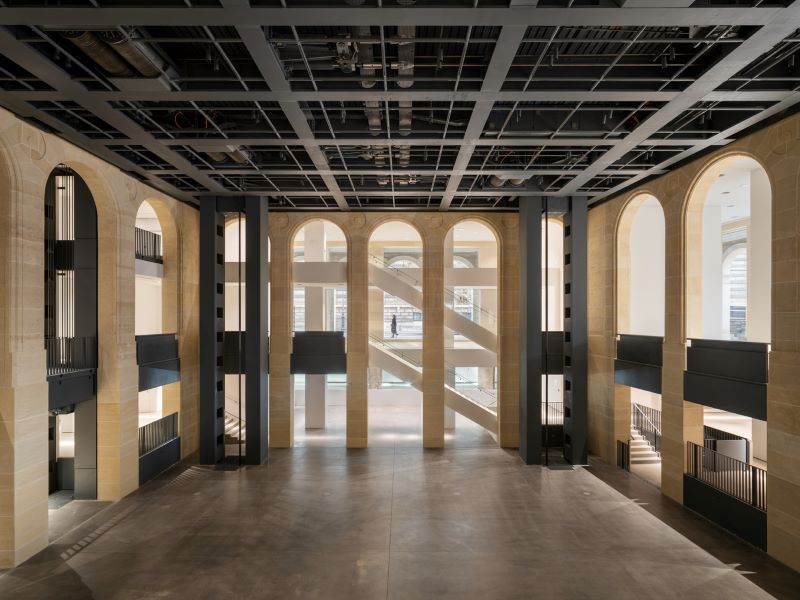The new venue of the Cartier Foundation for Contemporary Art, designed by Jean Nouvel, opened on October 25, 2025, at 2 Place du Palais Royal in Paris. The architectural project transforms the 19th-century Grands Magasins du Louvre into a mobile organic structure. The inaugural exhibition “Exposition Générale”, designed by Formafantasma, brings together over 600 works by more than 100 artists. Through scene design that reactivates the museum concept, it reflects four decades of contemporary creation.
Architectural Transformation Details
Jean Nouvel’s renovation of the Cartier Foundation’s new site reimagines this 19th-century Haussmann-style landmark as a dynamic machine for art. Inside the restored former Grands Magasins du Louvre, Nouvel introduced a system of five massive mobile platforms. These platforms can be raised and lowered to constantly reshape the exhibition space.
Within the historic Haussmannian building, the French architect stripped it down to its core, creating large transparent spaces where light and movement intertwine to deliver an immersive experience. Each of the five huge steel platforms covers an area of 250 square meters and weighs 250 tons. Suspended by a cable pulley system designed in collaboration with bridge and theater design experts, the platforms can be raised or lowered as needed. They allow for infinite reconfigurations, forming ever-changing spatial patterns that can expand, contract, or even disappear completely.
Exhibition Concept and Themes
Nouvel’s design engages in a dialogue with the building’s layered history. The Grands Magasins du Louvre was built in 1855 for the first Paris World’s Fair, where it hosted the Paris Exposition and served as a grand showcase of industrial modernization. The Cartier Foundation’s opening exhibition revives this spirit of exploration.
Centered on four themes—”Architectural Machine”, “Nature”, “Making Things”, and “Un monde réel” (A Real World)—the exhibition features nearly 600 works from the foundation’s collection by over 100 artists. Notable names include David Lynch, Patti Smith, James Turrell, Claudia Andujar, Sarah Sze, Junya Ishigami, Cai Guo-Qiang, and Diller Scofidio + Renfro.

To realize this ambitious reopening, Formafantasma’s exhibition design extends Jean Nouvel’s architectural vision into a curatorial experiment. Drawing on 19th-century trade fair display systems, the design team reimagines the exhibition as a space for social interaction and experimentation. Materials, lighting, and spatial rhythm evoke the site’s cultural heritage while highlighting the performative aspects of display and viewing. Formafantasma places artworks within an interdisciplinary, cross-temporal, and cross-worldview network of exchange.
Exhibition Section Breakdown
The sections of “Exposition Générale” unfold through the mechanical flexibility of Jean Nouvel’s architecture. The “Architectural Machine” section turns the first platform into an “urban laboratory”. From Alessandro Mendini’s “Microcathedrals” to Freddy Mamani’s vibrant “Salón de eventos” (Event Hall), the latest design concepts and utopian models reimagine the city as a space for transformation.
The “Nature” section shifts focus to the real world, converting the indoor space into a sensory ecosystem. Solange Pessoa’s feather installation hovers above works by Claudia Andujar, Giuseppe Penone, and Bernie Krause. The “Making Things” section traces the fluid boundaries between craftsmanship, design, and fine art. The “Un monde réel” section explores the intersection of science, technology, and fiction through immersive works, such as Sarah Sze’s “Tracing Falling Sky” and Diller Scofidio + Renfro’s data-driven “EXIT”.










